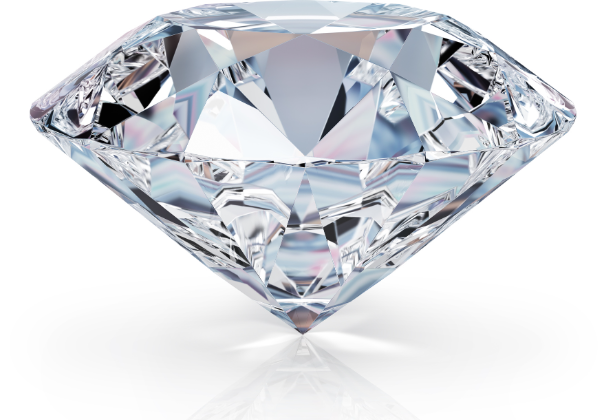Types of Diamonds?

Diamonds are precious and rare stones that are found inside the earth’s surface. A natural diamond is a gemstone or precious stone made up of carbon. Due to environmental concerns, lab-grown diamonds also called as lab-created diamonds are being preferred over mined diamonds.
Lab-created diamonds are created in a controlled environment by using the high-pressure high-temperature method (HPHT) and the chemical vapor deposition method (CVD). HPHT diamonds and CVD diamonds are exactly similar to natural diamonds.
Diamond Types
Diamonds can be classified into 4 types: -1a,1b,2a,2b. Diamonds are classified according to the level of their chemical impurities.
Type 1 Diamonds
Type 1 diamonds contain nitrogen. About 98% of all diamonds are type 1a.
Type 1a :-
In type 1a diamonds, nitrogen atoms are clustered together within the carbon lattice. They are of pale-yellow colour. When the nitrogen atoms are present in groups of three, they absorb wavelengths of visible light on the blue end of the spectrum. Hence, the light that is reflected appears to be yellow. Around 98% of the diamonds are type 1a.
Type 1a diamonds are further classified into 1aA and 1aB. 1aA are diamonds with nitrogen in aggregate pairs, and 1aB contains aggregates of four nitrogen atoms.
Type 1b :-
In type 1B diamonds, single nitrogen atoms instead of clusters are dispersed throughout the crystal lattice. As they are scattered, a lot of visible light is absorbed resulting in darker colours.
Type 2 Diamonds
Type 2 are diamonds that absorbed no, or very few, nitrogen atoms.
Type 2a :-
Type IIA diamonds are considered the purest form of diamonds. They contain no or very less impurities. They are considered the most rare and valuable type of diamonds. They contain a very little amount of nitrogen so they don’t easily absorb short-wave light. They are colourless and are almost transparent.
Type 2b Diamonds :-
Type IIB Diamonds do not contain nitrogen, but they contain boron. The presence of boron makes these diamonds electrically conductive. All naturally blue diamonds belong to Type 2b. They are extremely rare and form 0.1% of the diamonds.
{"AutoID":32,"DateCreation":"\/Date(1605034385110)\/","DateModified":"\/Date(1711528712890)\/","CreatedBy":null,"ModifiedBy":"Rahul Bohra ","RecordStatus":"A","Title":"Types of Diamonds?","SubTitle":"Diamonds are precious \u0026 rare stones which are found inside the earth’s surface. Anatural diamond is a gemstone/precious stone made up of carbon.Due to environmental concerns Lab Grown Diamon...","Description":"\u003cp\u003eDiamonds are precious and rare stones that are found inside the earth\u0026rsquo;s surface. A natural diamond is a gemstone or precious stone made up of carbon. Due to environmental concerns, \u003ca href=\"https://www.growndiamondcorp.com/\"\u003elab-grown diamonds\u003c/a\u003e\u0026nbsp;also called as\u0026nbsp;lab-created diamonds\u0026nbsp;are being preferred over\u0026nbsp;\u003ca href=\"https://www.growndiamondcorp.com/blog/can-you-easily-distinguish-between-a-mined-and-a-lab-grown-diamond/\"\u003emined diamonds\u003c/a\u003e.\u003c/p\u003e\r\n\r\n\u003cp\u003e\u0026nbsp;\u003c/p\u003e\r\n\r\n\u003cp\u003e\u003ca href=\"https://www.growndiamondcorp.com/blog/lab-created-diamonds/\"\u003eLab-created diamonds\u003c/a\u003e\u0026nbsp;are created in a controlled environment by using the high-pressure high-temperature method (\u003cstrong\u003eHPHT\u003c/strong\u003e) and the chemical vapor deposition method (\u003cstrong\u003eCVD\u003c/strong\u003e). \u003ca href=\"https://www.growndiamondcorp.com/blog/hpht-lab-grown-diamonds-history-process-and-benefits/\"\u003eHPHT diamonds\u003c/a\u003e and \u003ca href=\"https://www.growndiamondcorp.com/blog/cvd-diamonds-everything-you-need-to-know/\"\u003eCVD diamonds\u003c/a\u003e are exactly similar to natural diamonds.\u003c/p\u003e\r\n\r\n\u003cp\u003e\u0026nbsp;\u003c/p\u003e\r\n\r\n\u003ch2\u003e\u003cstrong\u003eDiamond Types\u003c/strong\u003e\u003c/h2\u003e\r\n\r\n\u003cp\u003eDiamonds can be classified into 4 types: -1a,1b,2a,2b. Diamonds are classified according to the level of their chemical impurities.\u003c/p\u003e\r\n\r\n\u003ch3\u003e\u003cstrong\u003eType 1 Diamonds\u003c/strong\u003e\u003c/h3\u003e\r\n\r\n\u003cp\u003eType 1 diamonds contain nitrogen. About 98% of all diamonds are type 1a.\u003c/p\u003e\r\n\r\n\u003ch4\u003e\u003cstrong\u003eType 1a :-\u003c/strong\u003e\u003c/h4\u003e\r\n\r\n\u003cp dir=\"ltr\"\u003eIn type 1a diamonds, nitrogen atoms are clustered together within the carbon lattice. They are of pale-yellow colour. When the nitrogen atoms are present in groups of three, they absorb wavelengths of visible light on the blue end of the spectrum. Hence, the light that is reflected appears to be yellow. Around 98% of the diamonds are type 1a.\u0026nbsp;\u003c/p\u003e\r\n\r\n\u003cp dir=\"ltr\"\u003e\u003cbr /\u003e\r\nType 1a diamonds are further classified into 1aA and 1aB. 1aA are diamonds with nitrogen in aggregate pairs, and 1aB\u0026nbsp; contains aggregates of four nitrogen atoms.\u003c/p\u003e\r\n\r\n\u003ch4\u003e\u003cstrong\u003eType 1b :-\u003c/strong\u003e\u003c/h4\u003e\r\n\r\n\u003cp\u003eIn type 1B diamonds, single nitrogen atoms instead of clusters are dispersed throughout the crystal lattice. As they are scattered, a lot of visible light is absorbed resulting in darker colours.\u003c/p\u003e\r\n\r\n\u003cp\u003e\u0026nbsp;\u003c/p\u003e\r\n\r\n\u003ch3\u003e\u003cstrong\u003eType 2 Diamonds\u003c/strong\u003e\u003c/h3\u003e\r\n\r\n\u003cp\u003eType 2 are diamonds that absorbed no, or very few, nitrogen atoms.\u003c/p\u003e\r\n\r\n\u003ch4\u003e\u003cstrong\u003eType 2a :-\u003c/strong\u003e\u003c/h4\u003e\r\n\r\n\u003cp\u003e\u003ca href=\"https://www.growndiamondcorp.com/blog/what-is-a-type-iia-lab-grown-diamond/\"\u003eType IIA diamonds\u0026nbsp;\u003c/a\u003eare considered\u0026nbsp; the purest form of diamonds. They contain no or very less impurities. They are considered\u0026nbsp; the most rare and valuable type of diamonds. They contain a very little amount of nitrogen so they don\u0026rsquo;t easily absorb short-wave light. They are colourless and are almost transparent.\u003c/p\u003e\r\n\r\n\u003ch4\u003e\u003cstrong\u003eType 2b Diamonds :-\u003c/strong\u003e\u003c/h4\u003e\r\n\r\n\u003cp\u003eType IIB Diamonds do not contain nitrogen, but they contain boron. The presence of boron makes these diamonds electrically conductive. All naturally blue diamonds belong to Type 2b. They are extremely rare and form 0.1% of the diamonds.\u003c/p\u003e\r\n","FromDate":null,"ToDate":null,"Image_Url":"types-of-diamonds.png","Image_Alt":"Types of Diamonds","KeyWords":"eco friendly diamonds, eco friendly diamond, certified eco friendly diamonds, eco diamonds, eco grown diamonds, grown diamond corporation, Keyword\r\nlab grown diamonds,lab created diamonds, cvd diamonds, type iia diamonds","MetaDescription":"What are the types of lab grown diamonds? Diamonds can be classified into 4 types: 1a, 1b, 2a, and 2b, \u0026 according to the level of their chemical impurities. Continue reading to learn more.","MetaTitle":"Types of Diamonds?","CanonicalLink":"https://www.growndiamondcorp.com/blog/types-of-diamonds/","MetaContent":"\u003c!-- Open Graph / Facebook --\u003e\r\n\u003cmeta property=\"og:type\" content=\"website\"\u003e\r\n\u003cmeta property=\"og:url\" content =\"https://www.growndiamondcorp.com/blog/types-of-diamonds/\"\u003e\r\n\u003cmeta property=\"og:title\" content=\"Types of Diamonds? | Grown Diamond Corporation\"\u003e\r\n\u003cmeta property=\"og:description\" content=\"What are the types of lab grown diamonds? Diamonds can be classified into 4 types: 1a, 1b, 2a, and 2b, \u0026 according to the level of their chemical impurities. Continue reading to learn more.\"\u003e\r\n\u003cmeta property=\"og:image\" content=\"https://docs.growndiamondcorp.com/blog/types-of-diamonds.png\"\u003e\r\n\r\n\u003c!-- Twitter --\u003e\r\n\u003cmeta property=\"twitter:card\" content=\"summary_large_image\"\u003e\r\n\u003cmeta property=\"twitter:url\" content=\"https://www.growndiamondcorp.com/blog/fashion-comes-alive-with-lab-grown-colored-diamonds/\"\u003e\r\n\u003cmeta property=\"twitter:title\" content=\"Types of Diamonds? | Grown Diamond Corporation\"\u003e\r\n\u003cmeta property=\"twitter:description\" content=\"What are the types of lab grown diamonds? Diamonds can be classified into 4 types: 1a, 1b, 2a, and 2b, \u0026 according to the level of their chemical impurities. Continue reading to learn more.\"\u003e\r\n\u003cmeta property=\"twitter:image\" content=\"https://docs.growndiamondcorp.com/blog/types-of-diamonds.png\"\u003e","SeqNo":5,"Slug":"types-of-diamonds","GetTitle":"types-of-diamonds","GetImageUrl":"https://docs.growndiamondcorp.com/blog/types-of-diamonds.png"}
© 2025 Grown Diamond Corporation - Lab Grown Diamonds. All rights reserved.| Sitemap




